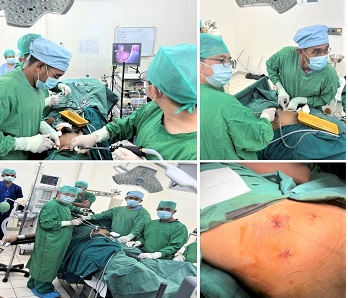Urinary stones are one of the most common urological diseases in Timor-Leste. Due to its tropical climate with high temperatures and significant water loss from the body, coupled with the high mineral content in drinking water, the incidence of stones is quite high. A few years ago, the Chinese medical team donated extracorporeal lithotripsy equipment to the National Hospital of Timor-Leste, providing patients with more efficient and minimally invasive treatment options. This year, the Hong Kong Sharing Foundation also donated a water purification system, which can effectively reduce the risk of stones and other diseases.
Main Causes of Urinary Stones
- Urine Composition and Concentration: High concentrations of minerals in urine can lead to the crystallization of salts and gradually form stones. Insufficient dilution of urine increases the risk of stone formation.
- Dietary Factors: High-salt diets, foods rich in oxalates, high animal protein intake, and low levels of citric acid contribute to stone formation.
- Infections: Certain bacteria in urinary tract infections can decompose urea, producing ammonia and alkaline urine, which promotes stone formation.
- Metabolic Disorders: Conditions such as hypercalciuria and hyperuricemia can lead to stone formation.
- Environment and Lifestyle: High-temperature environments cause dehydration and concentrated urine. Long-term consumption of water with high mineral content increases risk. Lack of physical activity also raises the likelihood of stone formation.
Urinary stones may cause acute pain, infections, and kidney damage. Therefore, early prevention, regular check-ups, and appropriate treatment are essential.
Preventive Measures
- Increase Water Intake: Drink 2–3 liters of water daily to promote urine dilution.
- Adjust Diet: Reduce salt, animal protein, and oxalate-rich foods while increasing citrus fruits and citric acid to prevent stone formation.
- Engage in Regular Exercise and Health Check-ups.
Treatment Methods
- Medication Therapy:
- Stone-expelling drugs: α-blockers (e.g., tamsulosin) can help pass small stones.
- Stone-dissolving drugs: For uric acid stones, alkalization and dissolution therapy (e.g., sodium bicarbonate or potassium citrate) is used.
- Calcium stone patients: Diuretics may be prescribed to reduce calcium excretion in urine.
- Non-surgical Therapy:
- Extracorporeal Shock Wave Lithotripsy (ESWL): Suitable for smaller stones, uses high-energy sound waves to break stones into smaller pieces.
- Surgical Therapy:
- Ureteroscopic lithotripsy: Uses lasers or pneumatic energy to break and remove stones via a ureteroscope.
- Percutaneous Nephrolithotomy (PCNL): For larger or complex kidney stones, involves using a nephroscope with laser or pneumatic lithotripsy.
- Open or laparoscopic stone removal: Reserved for complex cases where other methods are ineffective.
- Other Therapies:
- Percutaneous Nephrostomy (PCN) and Ureteral Stent Placement: Often used to relieve urinary obstruction caused by hydronephrosis or pyonephrosis, protect kidney function, and prepare for subsequent treatment.

The treatment of urinary stones should be tailored based on the type, size, location of the stones, and the patient’s overall health condition. At the same time, prevention and treatment complement each other; adopting healthy lifestyle habits can effectively reduce the occurrence of stones.
By Dr.Xie Guoping,Urologist.
